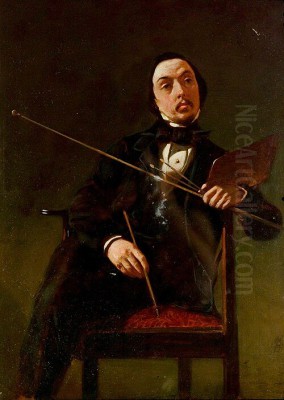
Edmund John Niemann stands as a significant figure in the landscape of 19th-century British art. A prolific and popular painter during his lifetime, he captured the diverse scenery of England and Wales with a distinctive blend of naturalistic observation and romantic sensibility. Though perhaps less universally known today than some of his contemporaries, Niemann's extensive body of work offers a valuable and evocative visual record of Victorian Britain, particularly the vistas along the River Thames and the rugged beauty of Yorkshire. His journey from a clerk at Lloyd's of London to a dedicated professional artist highlights a passionate commitment to capturing the essence of the British countryside.
Early Life and a Change of Path
Edmund John Niemann was born in Islington, North London, in 1813. His background was somewhat international for the time; his father, John Diedrich Niemann, was a German native of Minden, Westphalia, who worked as a member at the prestigious financial institution, Lloyd's of London. Following perhaps in his father's footsteps, or simply seeking stable employment, the young Edmund began working at Lloyd's as a clerk at the tender age of thirteen.
For over a decade, Niemann remained in the world of finance and insurance. However, the lure of art proved irresistible. In 1839, at the age of about twenty-six, he made the decisive and life-altering choice to leave his position at Lloyd's and dedicate himself entirely to painting. This was a bold move, exchanging the security of a clerkship for the uncertain prospects of an artistic career in a competitive era.
To pursue his new vocation, Niemann relocated from the bustling metropolis of London to the quieter surroundings of High Wycombe in Buckinghamshire. This move likely provided him with greater access to the rural landscapes that would become central to his art, particularly the scenic stretches of the nearby River Thames. It marked the true beginning of his journey as a professional landscape painter.
Artistic Development and Key Influences
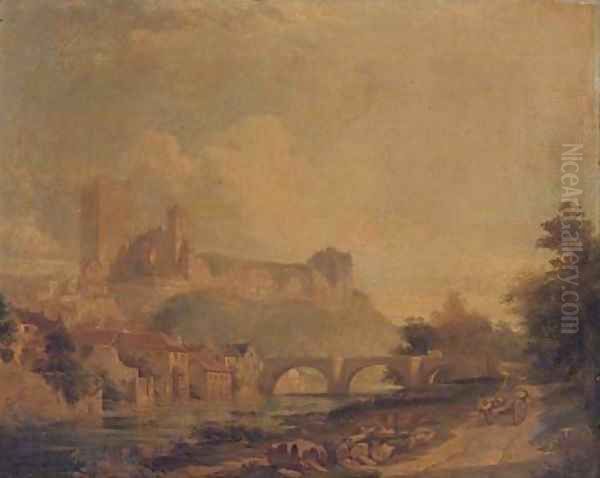
Niemann appears to have been largely self-taught, or at least developed his style outside the formal structures of the Royal Academy Schools. His work demonstrates a keen observational skill combined with an understanding of prevailing artistic trends. The most significant influences on his style were undoubtedly the giants of British landscape painting who preceded him: John Constable and J.M.W. Turner.
From Constable, Niemann absorbed a commitment to naturalism, the detailed observation of the English countryside, and the effects of light and weather. Constable's dedication to capturing the specificities of place and atmosphere resonates in Niemann's own depictions of recognisable locations. The freshness and directness found in Constable's work can often be sensed in Niemann's handling of foliage, water, and skies.
The influence of J.M.W. Turner is also palpable, particularly in Niemann's more dramatic and atmospheric compositions. Turner's mastery of light, his ability to evoke sublime and powerful natural forces, and his often more generalised, emotionally charged rendering of landscapes seem to inform Niemann's treatment of dramatic skies, misty distances, and the interplay of light and shadow. Niemann often incorporated elements associated with Romanticism – brooding clouds, rugged terrain, ancient structures shrouded in mist – echoing Turner's more evocative works.
While Constable and Turner were primary influences, Niemann worked within a broader tradition of British landscape painting. He would have been aware of the work of earlier watercolourists like Thomas Girtin and Richard Parkes Bonington, who helped establish landscape as a major genre, and contemporaries such as David Cox and Peter De Wint, known for their expressive handling of landscape subjects.
Style and Technique
Niemann worked primarily in oils, developing a style characterised by its vigour, naturalistic colour, and atmospheric depth. His approach balanced detailed rendering in the foreground with a broader, more suggestive handling of distant elements, creating a convincing sense of space and perspective. His brushwork could be precise in depicting architectural details or the texture of foliage, yet also fluid and expressive in capturing moving water or cloud formations.
His colour palette was generally grounded in natural observation, reflecting the greens, browns, and blues of the British landscape. However, he was not afraid to employ stronger contrasts and more dramatic lighting effects, particularly in his depictions of sunrise, sunset, or stormy weather, leaning into the romantic sensibility influenced by Turner. He skillfully rendered the effects of light on water, the transparency of shadows, and the subtle gradations of tone in the sky.
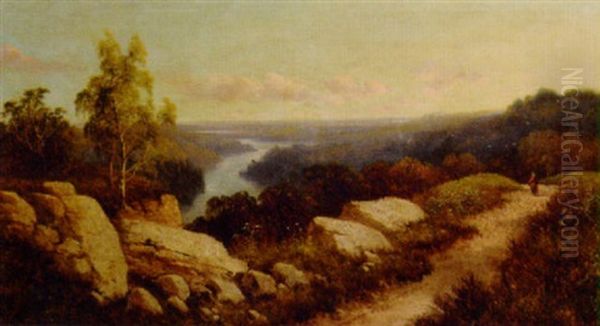
Compositionally, Niemann often favoured panoramic views or scenes framed by trees, leading the viewer's eye into the landscape. River scenes, a frequent subject, typically feature a strong diagonal recession, drawing attention towards a distant bridge, town, or bend in the river. His paintings often include elements of human activity – figures fishing, boats on the water, distant villages – which serve to animate the scene and provide a sense of scale, grounding the romantic elements in a lived reality.
Favourite Themes and Locations
While Niemann travelled and painted across various parts of Britain, certain locations feature prominently in his oeuvre. He is particularly renowned for his depictions of the River Thames, especially the stretches in Buckinghamshire and Berkshire near his home in High Wycombe. He captured the river in its many moods, from tranquil pastoral scenes to busier views incorporating towns like Great Marlow and Henley.
Yorkshire was another region that clearly captivated Niemann. He painted numerous views of its dramatic coastline, castles, and river valleys, particularly around Richmond and Whitby. These works often showcase the more rugged and romantic aspects of his style, depicting ancient ruins, rolling hills, and expansive skies. His Yorkshire scenes frequently convey a sense of history and the power of nature.
Beyond these core areas, Niemann also painted landscapes in Wales, Somerset, Herefordshire, and other parts of England. His subjects ranged from tranquil woodland streams and rural cottages to grander views of mountains, estuaries, and coastal cliffs. Castles and ruins were recurring motifs, adding a layer of historical romance to the natural scenery.
Representative Works
Among Niemann's vast output, several paintings stand out as representative of his style and preferred subjects. 'Shooter's Hill, Kent, from the Thames' and 'Fishing Boats on the Beach, Fowey, Cornwall' showcase his ability to handle different types of landscapes, from river views near London to coastal scenes.
His depictions of the Thames valley are numerous and highly regarded. Works such as 'View on the Thames near Great Marlow' (sometimes identified or related to 'The Thames and the Dymond Park') exemplify his skill in capturing the gentle beauty of the river, the lushness of the surrounding countryside, and the interplay of light on water.
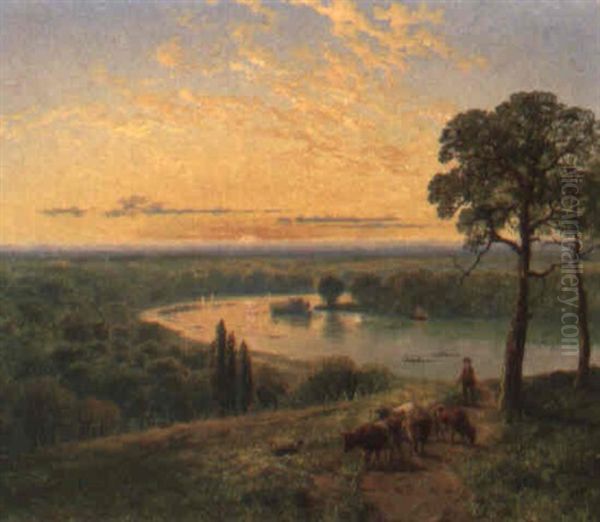
Paintings like 'Richmond Castle, Yorkshire' or 'On the Wharfe, Yorkshire' demonstrate his engagement with the northern landscape, often employing a more dramatic composition and atmospheric effects. 'Mountain Scene near Barmouth' highlights his work in Wales, capturing the grandeur of mountainous terrain. Other titles like 'Stream Mountain' suggest his interest in more intimate, secluded natural scenes. These works, and many others like them, cemented his reputation as a versatile and accomplished landscape painter.
Exhibitions and Professional Engagement
Niemann was actively involved in the London art world and exhibited his works widely. He showed paintings at the prestigious Royal Academy between 1844 and 1872, indicating acceptance by the established art institution. He also exhibited frequently at the British Institution and the Society of British Artists on Suffolk Street. His work was seen further afield at venues like the Royal Scottish Academy and various regional exhibitions, including the Bristol Fine Arts Academy.
Significantly, Niemann played a key role in challenging the perceived exclusivity of the established art societies. In 1848, he was instrumental in founding the "Free Exhibition" at the Portland Gallery, Regent Street. This venture aimed to provide artists with an alternative venue, free from the restrictive selection processes of institutions like the Royal Academy. Niemann served as one of its trustees and honorary secretary.
In 1850, this "Free Exhibition" was reorganised and renamed the "National Institution". Niemann continued his involvement with this body, which held exhibitions at the Portland Gallery and later the Gallery of the Society of Painters in Water Colours. His participation in this initiative suggests a degree of dissatisfaction with the established art hierarchy and a desire to create more open opportunities for artists, reflecting a spirit of independence also seen in his decision to pursue art professionally without formal academic training.
Niemann in the Context of Victorian Art
Edmund John Niemann worked during a dynamic period in British art. The high tide of Romanticism, exemplified by Turner's later work, was gradually giving way to the detailed realism and moral seriousness of the Pre-Raphaelite Brotherhood (founded in 1848), whose members included John Everett Millais, Dante Gabriel Rossetti, and William Holman Hunt. While Niemann's style differed significantly from the Pre-Raphaelites' meticulous detail and symbolic subject matter, he shared the Victorian era's deep appreciation for nature.
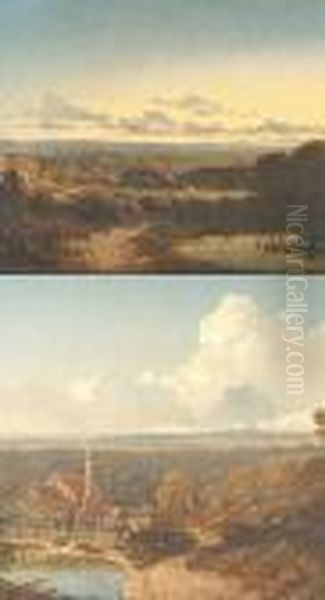
Landscape painting remained immensely popular throughout the Victorian period. Niemann's contemporaries included artists like John Linnell, known for his rich, pastoral scenes often imbued with a spiritual quality similar to the earlier work of Samuel Palmer. Benjamin Williams Leader achieved enormous popular success later in the century with his highly polished, somewhat sentimental landscapes. Atkinson Grimshaw developed a unique niche depicting moonlit urban and dockland scenes, sharing Niemann's interest in atmosphere but with a different focus.
Niemann's work sits comfortably within the mainstream of Victorian landscape painting, blending the romantic legacy of the early 19th century with the era's growing taste for naturalistic detail. He did not radically innovate in the manner of Turner or Constable, nor did he align himself with avant-garde movements like the Pre-Raphaelites or, later, Impressionism (which was developing in France during his final years, with artists like Claude Monet and Camille Pissarro). Instead, he skillfully synthesised existing traditions to create appealing and accomplished views of the British Isles.
His prolific output catered to a growing middle-class market for art, particularly landscape paintings that celebrated the national scenery. His success at major exhibitions and the sheer number of works he produced attest to his popularity during his lifetime.
Later Life and Legacy
Edmund John Niemann continued to paint actively throughout his life. He eventually moved back closer to London, residing in Brixton, Surrey. It was there, at his home on Brixton Hill, that he passed away suddenly from apoplexy (a stroke) on April 15, 1876, at the age of 63.
His death marked the end of a productive and successful career. Niemann left behind a substantial body of work that found its way into numerous private and public collections. Today, his paintings are held by institutions such as the Victoria and Albert Museum in London, the Bank of England Museum, the Ferens Art Gallery in Hull, the Rotherham Heritage Services, and Sheffield Galleries and Museums Trust, among others.
In art historical terms, Niemann is generally regarded as a talented and significant second-tier Victorian landscape painter. While not possessing the groundbreaking vision of Constable or Turner, he was a highly competent artist who expertly captured the character of the British landscape. His work remains popular with collectors of traditional British art, valued for its technical skill, atmospheric beauty, and evocative portrayal of specific locations.
His contribution also lies in his sheer productivity, offering a wide-ranging visual survey of Britain in the mid-19th century. Furthermore, his involvement in establishing the "Free Exhibition" highlights his role in the professional dynamics of the Victorian art world, advocating for greater opportunities for artists outside the established academies.
Conclusion
Edmund John Niemann carved a successful path as a landscape painter in Victorian Britain, driven by a clear passion for the art form that led him away from a conventional career. Influenced by the great masters Constable and Turner, he developed a distinctive style that balanced naturalistic observation with a romantic sensibility, capturing the varied landscapes of England and Wales with skill and atmosphere. From the gentle meanders of the Thames to the rugged hills of Yorkshire, his paintings offer an enduring vision of the 19th-century British countryside. Though perhaps overshadowed by the very greatest names, Niemann remains an important figure, a prolific chronicler of his time whose works continue to be appreciated for their artistry and historical resonance.